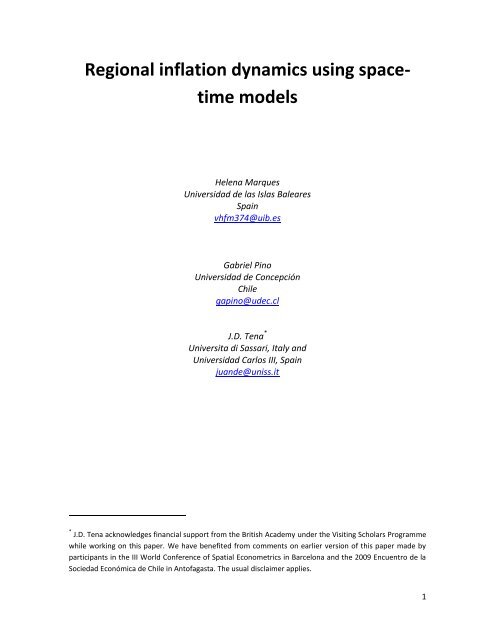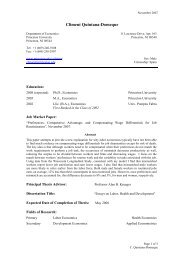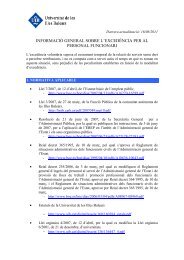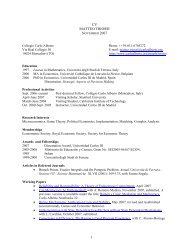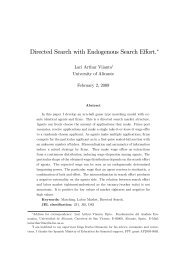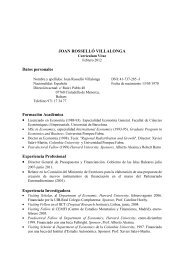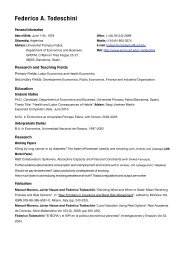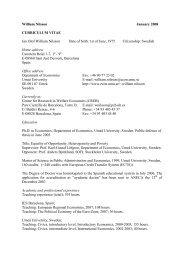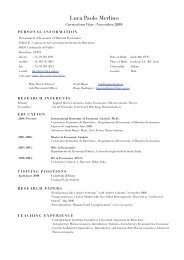Regional inflation dynamics using space- time models
Regional inflation dynamics using space- time models
Regional inflation dynamics using space- time models
You also want an ePaper? Increase the reach of your titles
YUMPU automatically turns print PDFs into web optimized ePapers that Google loves.
<strong>Regional</strong> <strong>inflation</strong> <strong>dynamics</strong> <strong>using</strong> <strong>space</strong><strong>time</strong><br />
<strong>models</strong><br />
Helena Marques<br />
Universidad de las Islas Baleares<br />
Spain<br />
vhfm374@uib.es<br />
Gabriel Pino<br />
Universidad de Concepción<br />
Chile<br />
gapino@udec.cl<br />
J.D. Tena *<br />
Universita di Sassari, Italy and<br />
Universidad Carlos III, Spain<br />
juande@uniss.it<br />
* J.D. Tena acknowledges financial support from the British Academy under the Visiting Scholars Programme<br />
while working on this paper. We have benefited from comments on earlier version of this paper made by<br />
participants in the III World Conference of Spatial Econometrics in Barcelona and the 2009 Encuentro de la<br />
Sociedad Económica de Chile in Antofagasta. The usual disclaimer applies.<br />
1
Abstract<br />
This paper provides empirical evidence of the role of spatial factors on the determination of<br />
<strong>inflation</strong> <strong>dynamics</strong> for a representative set of tradable commodities in Chile. We present a simple<br />
model that explains <strong>inflation</strong> divergence across regions in a monetary union with similar<br />
preferences as a consequence of the geographical allocation of producers in the different regions.<br />
Our results indicate that spatial allocation together with transport costs are important<br />
determinants of regional <strong>inflation</strong> while macroeconomic common factors do not play an important<br />
role in this process. Existing literature had obtained the opposite result for Europe and the reasons<br />
for that difference warrant further investigation. Moreover, we find that geographical distance<br />
seems to be a more appropriate measure of neighbourhood than the adjacent of regions.<br />
Keywords: regional <strong>inflation</strong> <strong>dynamics</strong>, <strong>space</strong>-<strong>time</strong> <strong>models</strong>, Chile<br />
JEL codes: E31, E52, E58, R11, C23, C21<br />
2
1. Introduction<br />
Explaining persistent <strong>inflation</strong> differentials across the various geographical areas that make<br />
up a monetary union has been a recurrent topic in the economic literature. Two recent and<br />
important contributions in this field are Altissimo et al (2005), who present a theoretical model to<br />
explain <strong>inflation</strong> dispersion in the non traded sector, and Andres et al. (2008) who focus on<br />
tradable goods, suggesting that <strong>inflation</strong> differentials may be substantial over the business cycle<br />
mainly because of different preferences of individuals in different countries.<br />
In this paper we show that another factor - transport costs - can explain persistent<br />
<strong>inflation</strong> differentials for tradable goods even when individual preferences in the different regions<br />
are identical. This intuition is motivated with a simple modified version of the Obstfeld and Rogoff<br />
(1995) model (O&R henceforth) for two different regions in a monetary union. Unlike O&R, in our<br />
model exchange rates are fixed and do not adjust to fulfill the law of one price. Instead, under<br />
sticky prices and in the presence of transport costs, the proportion of producers in the two regions<br />
can explain the asymmetric reactions of regional prices and incomes to the same type of macro<br />
shocks and thus explain persistent <strong>inflation</strong> divergence across the monetary union.<br />
The role of spatial factors in the determination of <strong>inflation</strong> <strong>dynamics</strong> is tested for a<br />
representative set of 98 tradable commodities, whose prices have been taken monthly for 23<br />
cities of Chile in the period 2003:01-2006:09. Due to its natural geography and climate that<br />
prevent perfect price arbitrage, the Chilean case allows a natural application of spatial<br />
econometric <strong>models</strong> to the explanation of the heterogeneity of <strong>inflation</strong> <strong>dynamics</strong> at the regional<br />
and product level.<br />
This paper introduces two important novel features with respect to previous work that<br />
tested spatial price homogeneity (law of one price), such as Parsley and Wei (1996) and Ceccheti<br />
et al. (2002) for the U.S., or Beck et al. (2009) for the Euro Area. First, as far as we are aware, ours<br />
is the first attempt to investigate the heterogeneity of <strong>inflation</strong> <strong>dynamics</strong> for an emerging market<br />
with such a level of detail. Indeed, we explore the product and geographical dimensions of Chilean<br />
<strong>inflation</strong> <strong>using</strong> spatial econometric <strong>models</strong>. The second aspect relates to our study of <strong>inflation</strong><br />
dispersion for individual prices and not for price indices. This is an important issue given that a<br />
price index could evolve differently across regions just because of different weights in the<br />
3
epresentative basket of consumption. The individual consideration of homogeneous product<br />
categories eliminates this problem.<br />
Our results indicate an important degree of spatial correlation in the determination of<br />
commodity prices, supporting the theoretical result that persistent <strong>inflation</strong> differences across<br />
<strong>space</strong> can be due to the geographical allocation of producers. Also, in contrast to what Beck et al.<br />
(2009) have found for the Euro Area, in Chile common macroeconomic factors only explain a small<br />
proportion of the variability of <strong>inflation</strong> for the different commodities.<br />
The structure of this paper is as follows. Section 2 proposes a simple model that explains<br />
regional divergence in the <strong>inflation</strong> rates through the role of transport costs. The following section<br />
presents the dataset used in the empirical analysis and explains some of its features. Section 4<br />
discusses the most important empirical results obtained from the estimation of a range of spatial<br />
econometric <strong>models</strong>. Some concluding remarks follow in Section 5.<br />
2. Theoretical underpinnings<br />
The role of transport costs in determining <strong>inflation</strong> <strong>dynamics</strong> can be explained theoretically<br />
by a simplified version of the O&R model for different regions in a single country. An important<br />
feature of this framework is that all goods are traded but imported goods are subject to a<br />
transport cost. Unlike O&R who focus their attention on the effect of monetary policy and the<br />
exchange rate adjustment to maintain the purchasing power parity between prices in two<br />
different countries, here we deal with regions inside the same country and the relationships<br />
between prices in each region are governed by transport costs instead of exchange rates. Under<br />
the assumption of sticky prices, shocks to demand and transport costs can alter relative prices and<br />
generate asymmetric reactions across regions, even if all individuals have the same preferences<br />
independently of their location.<br />
We assume the world is inhabited by a continuum of individual monopolistic producers,<br />
indexed by z ∈ 0,1 , each of whom produces a single differentiated good, also indexed by z. All<br />
4
producers locate in one of two regions, central or peripheral. Central regions produce in the<br />
interval 0, n , whereas peripheral regions are located in (n, 1]. Each agent located in one of the<br />
regions produces a variety of one type of good, y z , in which that region is specialized.<br />
Independently of their location, all producers sell some of their production in the central market,<br />
y C,t z , and the rest in the peripheral market, y P,t z = y z − y C,t z . Because each variety is<br />
unique, they enjoy some monopolistic power at both their home region and outside.<br />
All individuals throughout the country have identical preferences over a consumption index,<br />
real money balances and effort expended in production, whether they locate in the central or in<br />
the peripheral region. The intertemporal utility function of a typical agent<br />
is given by<br />
U t j =<br />
∞<br />
s=t<br />
The variable C is a real consumption index<br />
β s−t logC j s + χlog M j<br />
s<br />
− κ P s 2 y s(j) 2<br />
(2.1)<br />
C j =<br />
1<br />
c j (z) θ−1<br />
θ dz<br />
0<br />
θ<br />
θ−1<br />
(2.2)<br />
where c j (z) is the jth Home individual’s consumption of good z, and θ > 1.<br />
Let p(z) be the Home-currency price of good z. Then the Home money price index is<br />
P =<br />
1<br />
p(z) 1−z dz<br />
0<br />
1<br />
1−θ<br />
(2.3)<br />
The most important difference between this framework and the O&R model is the<br />
derivation of the relationship between P and P ∗ . Here, it is assumed that all goods can be traded,<br />
although in doing so transport costs are incurred according to an iceberg transport technology<br />
(see Fujita et al. 1999). Then, if the transport cost of a good from one region to another is T t , the<br />
relationship between the prices in the two regions is given by<br />
5
p z T t = p ∗ (z) if z ≤ n<br />
p z = T t p ∗ (z) if z > n (2.4)<br />
where T t > 1.<br />
Now, we can write the central price index as<br />
P =<br />
1<br />
p(z) 1−z dz<br />
0<br />
1<br />
1−θ<br />
=<br />
n<br />
p(z) 1−θ dz<br />
0<br />
1<br />
+ T t p ∗ (z) 1−θ dz<br />
n<br />
1<br />
1−θ<br />
(2.5)<br />
Similarly, the peripheral price index is<br />
P ∗ =<br />
1<br />
p ∗ (z) 1−z dz<br />
0<br />
1<br />
1−θ<br />
=<br />
0<br />
n<br />
p z Tt 1−θ dz<br />
1<br />
+ p ∗ (z) 1−θ dz<br />
n<br />
1<br />
1−θ<br />
(2.6)<br />
An important point to note is that, although all agents have similar preferences, the law of<br />
one price is not necessarily met. In general:<br />
P ≠ P ∗ (2.7)<br />
Prices in the central and peripheral regions will be different if the location of agents in the<br />
two regions is asymmetric. In this model, the proportion of individuals allocated to the different<br />
regions is considered exogenous as the location decision could be affected by geographical,<br />
political, economic and historical reasons. Hence we can suppose that in general the allocation of<br />
producers will in fact be asymmetric. As we show later, in this case transport costs play a key role<br />
in perpetuating price dispersion.<br />
Similarly to O&R, the only internationally traded asset is a riskless real bond denominated in<br />
the composite consumption good. The period budget constraint for a representative Home<br />
individual<br />
can be written in nominal terms as<br />
6
j<br />
P t B t+1<br />
+ M t = P t 1 + r t B t j + M t−1 + p t j y t j − P t C t<br />
j<br />
2.8<br />
where r t denotes the real interest rate on bonds between t − 1 and t, y t j is output for good j<br />
j<br />
and p t j is the domestic currency price. The variable M t−1<br />
balances entering at period t.<br />
is agent j′ s ′ holdings of nominal money<br />
The economy is closed and we do not consider a foreign country as our interest lies in<br />
analyzing the differences across regions in the same country. Therefore, a single monetary<br />
aggregate is considered for both regions. Under the assumption that the monetary authority runs<br />
a balanced budget at each period and given that, for simplicity, we do not consider taxes and<br />
government spending, the following condition must be verified<br />
0 = M t − M t−1<br />
P t<br />
(2.9)<br />
The set of equilibrium conditions obtained by following a similar approach to O&R is<br />
confined to Appendix 1. Given that prices are determined by monetary policy and both regions<br />
face the same type of monetary policy shocks the only value of t t that is consistent with similar<br />
prices in the central and peripheral areas is t t = 0. However, it is far more interesting to study the<br />
case in which transport costs are altered and the adjustment of prices to the new level of<br />
transport costs takes place with a one-period lag. Movements in transport costs could be<br />
explained either by a common demand shock that affects demand for all goods in the economy or<br />
by an international oil shock. In both cases, shocks at the national level will exert an asymmetric<br />
effect in the two regions. To see this, notice that, under sticky producer prices, any change in<br />
transport costs would alter consumer prices in the central and peripheral areas in the following<br />
way:<br />
p = 1 − n t (2.10)<br />
p ∗ = nt (2.11)<br />
7
If n > 0.5 the consumer price index after the shock will be higher in the peripheral region<br />
compared to the central region. This happens because individuals in the peripheral region have to<br />
pay for the cost of transporting all goods produced in the most populated areas (the central<br />
region). The asymmetry in consumer price indices also has an asymmetric effect on the level of<br />
consumption and income in the two areas, as given by the following equations:<br />
y − y ∗ = θ −nt + (1 − n)t (2.12)<br />
y − y ∗ = −<br />
θ<br />
1 + θ c − c∗ (2.13)<br />
Therefore, a shock to transport costs alters the distribution of income in the two regions.<br />
Moreover, by subtracting the Euler equations (2.12) and (2.13) in the central and peripheral<br />
regions it can be seen that these relative changes in consumption levels are always permanent.<br />
To sum up, it is clear from this model that the existence of transport costs effectively<br />
prevents the elimination of regional <strong>inflation</strong> differentials as changes in transport costs will lead to<br />
permanent changes in relative consumer prices in the two regions. Accordingly, we should find in<br />
the empirical analysis that regional <strong>inflation</strong> is not only determined by monetary policy but also by<br />
transport costs, which in turn are a function of the distance across production locations. Testing<br />
this theory for the case of Chile is the main task of the subsequent sections.<br />
3. Product <strong>inflation</strong> data<br />
For our analysis we collected a panel of prices covering an important range of different<br />
types of foods and drinks as well as oil products, summing up to a total of 98 different products.<br />
Price data was taken on a monthly basis in the period 2003:01-2006:09 for 23 cities that are<br />
representative of the 11 regions in Chile. Chile has an unusual ribbon-like shape which is on<br />
average 175 kilometers wide and 4,300 kilometers long. This length is higher than, for example,<br />
the distance from Madrid to Moscow (3,438 Km) - see Figure 1. A detailed description of the<br />
different sectors and regions considered is confined to Appendix 2.<br />
8
The data are freely available from the National Statistical Institute of Chile (“Instituto<br />
Nacional de Estadística”) at the URL http://www.ine.cl. This institution stopped publishing<br />
information on regional prices after September 2006 and so more recent data cannot be collected.<br />
However, even if this information had been available, <strong>inflation</strong> <strong>dynamics</strong> after that date followed a<br />
pattern that was not consistent with its equilibrium values in equilibrium and would represent an<br />
important break in the panel. More specifically, due to the higher increase in world food and oil<br />
since 2006, the average annual rate of Chilean <strong>inflation</strong> (i.e. the increase of the general index of<br />
consumer prices) was 7.8% and 7.1% in 2007 and 2008 respectively, while it had oscillated<br />
between 2% and 3% in the period 2004-2006.<br />
Inflation rates for each of the items (π t ) are computed as year-on-year percentage<br />
changes in the price index in the following way:<br />
π t = 100 ∗ P t − P t−12<br />
P t−12<br />
(3.1)<br />
where P t denotes the respective product price in a given region.<br />
Compared to other related papers such as Cecchetti et al. (1999), Beck et al. (2009) and<br />
Tena et al. (2009), an important advantage of our database is that we are considering individual<br />
prices instead of disaggregate price indices that include a basket of products even at the<br />
disaggregate level. These indices could evolve differently simply because of different regional<br />
tastes for the items in the consumption basket and not because of the different <strong>dynamics</strong> of prices<br />
in the different regions.<br />
There are no observations for item 28 (fish) in the city of Punta Arenas and therefore we<br />
exclude information from this city for that product. Besides, the panel contains a small number of<br />
missing values that represent about 0.5% of the total number of observations. We tackle such data<br />
irregularities in a factor model framework by <strong>using</strong> the EM algorithm together with PC<br />
decomposition (see for example Stock and Watson (2002) and Schumacher and Breitung (2008)).<br />
More specifically, <strong>using</strong> the <strong>inflation</strong> information available for the 23 cities, we estimate the most<br />
important common factors for governing <strong>inflation</strong> in each of the 98 items (except product 28<br />
whose observations are available for only 22 cities). Then, in a second step, the regression of each<br />
9
of the individual <strong>inflation</strong> series on the common factor is used to complete the missing values. The<br />
EM algorithm repeats steps 1 and 2 until convergence.<br />
For a formal test on the number of unit roots in the panel we follow Parsley and Wei<br />
(1996) by <strong>using</strong> the panel unit root test proposed by Levin et al. (2002). More precisely, for each of<br />
the 98 items, the basic regression specification is<br />
∆π k,t = c k + βπ k,t−1 +<br />
p<br />
γ i<br />
i=1<br />
∆π k,t−1 + ε t (3.2)<br />
where π k,t is the annual growth rate of prices in city k at <strong>time</strong> t; c k is the constant term specific to<br />
the kth city (i.e. we have a series of 23 dummies); and ε t is the error term.<br />
According to Levin et al. (2002), the critical values for T=25 and N=25 (that is,<br />
approximately our panel size) at the 1 and 5% significance levels are -8.27 and -7.74, respectively.<br />
The results of this test indicate that the null hypothesis of non stationarity could be rejected for<br />
70% of the commodities at the 5% level. Thus, <strong>inflation</strong> can be considered as being generated by a<br />
stationary process in most cases but not all. Indeed, there is an open debate in the literature on<br />
whether <strong>inflation</strong> is stationary or generated by a unit root process (see for example Culver and<br />
Papell (1997) for a discussion on this issue). Assuming that there is not an equilibrium rate for<br />
<strong>inflation</strong> is quite a strong hypothesis. But, it is also true that the mean level of <strong>inflation</strong> is typically<br />
affected by different stochastic breaks and to approximate these sporadic breaks with a unit root<br />
can be, in some circumstances, a good approach.<br />
According to this analysis we consider <strong>inflation</strong> as a stationary process and test the impact<br />
of spatial variables on its evolution. We also check the robustness of our results even if <strong>inflation</strong> is<br />
not stationary.<br />
4. Econometric specifications and results<br />
We initially estimate the following equation for each of the 98 commodities in the sample:<br />
10
π k,t = α k + β 1 π k,t−1 + β 2 f t + β 3 f t−1 + ε k,t (4.1)<br />
where π k,t is the annual <strong>inflation</strong> rate for the k-th city at <strong>time</strong> t; f t is a national common factor;<br />
and ε k,t is the error term. This specification is denoted as model M1. 2<br />
Note that equation (4.1) resembles the one proposed by Beck et al. (2009) in the sense<br />
that it considers the influence of national common factors at the national level on the <strong>dynamics</strong> of<br />
regional <strong>inflation</strong>. Indeed, to make our results comparable to Beck et al. (2009), we estimate<br />
common factors based on national macroeconomic variables such as the Chilean short-term<br />
interest rate, unemployment, the growth rate of oil prices, Chilean money supply, the nominal<br />
effective exchange rate, unit labour costs and industrial production. 3 However, unlike them, we<br />
only consider a common factor at the national level and not at the continental level because there<br />
is not a common monetary policy for all South American countries. A summary 4 of the estimation<br />
results - exhibited in the first column of Table 1 for the significance of each variable and in the first<br />
column of Table 2 for the explanatory power of each variable - shows that, for most commodities<br />
the <strong>dynamics</strong> of <strong>inflation</strong> is determined by its own past values and not by the common factors.<br />
We then test for the presence of spatial correlation in the residuals of the model by<br />
defining a weights matrix that takes positive values for cities in the same region and adjacent<br />
regions and zero otherwise. We do this by defining a spatial lag order as:<br />
L (1) π i =<br />
w ij<br />
(1) πj<br />
(4.2)<br />
j ∈G s<br />
j ≠i<br />
2 The model includes the lagged dependent variable, which is potentially endogenous. However, <strong>using</strong><br />
Monte Carlo simulations, Beck and Katz (2004) find that the nickel bias is low (2% or less) once T = 20, and<br />
they advise the use of a least-square estimator with a lagged dependent variable included if T is at least 20.<br />
Our sample contains 45 months, hence we do not correct for endogeneity of the lagged dependent variable.<br />
3 Appendix 2 contains a detailed description of these variables.<br />
4 Due to the large number of commodities used, only a summary of results is presented. The full set of<br />
results is available from the authors.<br />
11
where G s is the set of s neighbours of order (1).<br />
In this case, the weights w ij<br />
(1) depend on the number of cities in the different regions.<br />
For example, if for a certain location, there are 5 different cities in the same region and adjacent<br />
regions, w ij<br />
(1) = 1/5 for each of the 5 cities and 0 for the remaining ones. Therefore, the following<br />
properties are met: 1) w ij<br />
(s) ≥ 0; 2) wii<br />
(s) = 0; and 3)<br />
wij<br />
(s)<br />
j ∈G s<br />
j ≠i<br />
= 1 (see, for example, Anselin<br />
(1988) and Arbia (2006)).<br />
We carried out several tests of the presence of spatial correlation in the residuals of model<br />
(4.1), such as Moran’s I-statistic, the likelihood ratio test, the Wald test and the Lagrange<br />
multiplier test. The results of all the aforementioned tests indicate that the null of no spatial<br />
correlation could be rejected in more than 60% of the commodities at the 5% significance level. 5<br />
These results suggest that specification (4.1) could be improved by taking into account the<br />
interrelations of each city with other cities in the same and adjacent regions. Therefore, we<br />
augment the previous model by considering the following specification<br />
π k,t = α k + β 1 π k,t−1 + β 2 L (1) π k,t + β 3 L (1) π k,t−1 + β 3 f t + β 4 f t−1 + β 5 π t + β 6 π t−1 + ε k,t (4.3)<br />
where π t is the annual growth rate of the Chilean consumer price index. The augmented model is<br />
denoted by M2.<br />
This specification allows us to take into account spatial correlation in the <strong>inflation</strong> rates of<br />
the different cities and also the influence of the general <strong>inflation</strong> rate for each product. Note<br />
however that the likelihood function for model (4.3) cannot be maximized analytically due to the<br />
high degree of nonlinearity in the parameters. Therefore, we approximate this estimation by<br />
making use of the pseudo-likelihood procedure in LeSage (1999).<br />
5 See Anselin (1988) for a definition of the weights matrix in spatial econometric <strong>models</strong> and for different<br />
tests of spatial correlation.<br />
12
Space-dependency is found in 81% of the commodities, whilst the common factor<br />
determines <strong>inflation</strong> for only 10% of them at the 5% level (Table 1, second column). On average,<br />
the common factor explains 16% of the observed <strong>inflation</strong> variance, with the <strong>inflation</strong> of neighbour<br />
regions explaining 7% contemporaneously and 21% with a one period lag (Table 2, second<br />
column). This result confirms the theoretical hypothesis of section 2 according to which distance<br />
(transport cost) determine prices contemporaneously to some extent, but with a one-period lag to<br />
a higher extent. On the other hand, our empirical results are at odds with what Beck et al (2009)<br />
had found for Europe, where the macroeconomic common factor was the most important<br />
determinant of <strong>inflation</strong> <strong>dynamics</strong>. Moreover, the finding that neighbours matter more than<br />
common factors (even if with a <strong>time</strong> lag) justifies the introduction of spatially lagged variables in<br />
<strong>models</strong> of determination of regional <strong>inflation</strong>.<br />
The fact that a macroeconomic common factor is not an important variable to describe<br />
<strong>inflation</strong> <strong>dynamics</strong> in many commodities does not necessarily mean that an important part of the<br />
dispersion observed in the various commodity prices is not affected by a common shock at the<br />
national level. It could be that case that there are shocks specific to each commodity. This<br />
possibility is tested by obtaining a national common factor for each of the commodities from the<br />
<strong>inflation</strong> <strong>dynamics</strong> for that item in the 23 cities and estimating a model similar to (4.3), which we<br />
denote as M3. The consideration of commodity-specific common factors improves our<br />
econometric specifications. In fact, commodity-specific common factors are significant in 91% of<br />
the regressions compared to the 10% found in the previous specification (see third column of<br />
Table 1) and explain 31% of <strong>inflation</strong> <strong>dynamics</strong> compared to 16% previously (see third column of<br />
Table 2). However, also in this case spatial variables have a significant impact on the determination<br />
of prices for 62% of the commodities and do not lose explanatory power.<br />
One potential drawback of our empirical results is the ad hoc consideration of the weights<br />
matrix. In fact, the choice of weights is typically a discretionary decision made by the researcher<br />
and a different selection of neighbours could result in different conclusions. To deal with this<br />
problem we test whether the residuals of the previous model still contain some degree of spatial<br />
correlation that could be captured by a different contiguity matrix. In particular, we consider a<br />
second order of contiguity by defining regions that are neighbours of neighbours, L (2) , and a<br />
weights matrix based on kilometre distances instead of adjacent regions. That is, in the latter case<br />
w ij is defined as the distance from city i to j divided by the sum of distances from i to all the<br />
13
other 22 cities. We find that the second order of contiguity is significant in only 17% of the<br />
residuals while distance is significant in 60% of them at the 5% significance level.<br />
Given this result, a model similar to model M3 (model M4) was estimated <strong>using</strong> a<br />
contiguity matrix based on distance. Spatial variables became significant in 76% of the<br />
commodities under this specification (fourth column of Table 1) and maintain the same<br />
explanatory power (fourth column of Table 2), which suggests that, consistently with our theory, it<br />
is geographical distance and not administrative boundaries that influences <strong>inflation</strong> in the<br />
different cities.<br />
As a robustness exercise, we estimate a model similar to M4 by GMM (denoted as M5). 6<br />
Under GMM estimation, spatial variables exert an even more important role on the determination<br />
of <strong>inflation</strong> for the different commodities. Contemporaneous and lagged <strong>inflation</strong> in nearby cities<br />
are now significant for respectively 53% and 44% of the commodities (fifth column of Table 1) and<br />
they jointly explain 48% of <strong>inflation</strong> variance (fifth column of Table 2).<br />
Our final robustness exercise considers a similar estimation to M4 <strong>using</strong> variables in first<br />
differences (model M6). This specification makes sense given that, although the unit root tests<br />
performed in the previous section suggest that <strong>inflation</strong> is a stationary process, the evidence is not<br />
compelling (it was found for around 70% of the cases). The results of the estimation of model M6<br />
confirm that spatial variables also play an important role on the determination of the first<br />
differences of <strong>inflation</strong> for the various commodities (sixth columns of Tables 1 and 2).<br />
It is possible to conclude from this analysis that consistently with our theory spatial factors<br />
play a key role in the determination of Chilean <strong>inflation</strong>. Moreover, geographical distance seems to<br />
be a more appropriate measure of neighbourhood than the adjacency of regions. Common<br />
macroeconomic factors do not explain an important proportion of commodity price <strong>dynamics</strong>;<br />
however national factors that are specific to each commodity turn out to be important<br />
explanatory variables.<br />
6 The instruments used in the GMM estimation are: common factor (contemporaneous and first lag);<br />
national <strong>inflation</strong> (contemporaneous and two first lags); neighbour <strong>inflation</strong> (up to the fifth lag); dependent<br />
variable (second to fifth lags). The results are robust to the selected lags.<br />
14
5. Concluding remarks<br />
We have analysed the determinants of <strong>inflation</strong> for 98 commodities in 23 major Chilean<br />
cities. The results obtained indicate that <strong>inflation</strong> differentials can be observed across regions that<br />
are affected by the same type of macroeconomic shocks. One possible explanation for this finding<br />
is the key role played by geographical distance in the determination of <strong>inflation</strong> rates for the<br />
different cities. These empirical results are consistent with a model with sticky prices where the<br />
location of firms in the different regions of a country together with transport costs could explain<br />
<strong>inflation</strong> divergence that is persistent through <strong>time</strong>.<br />
Future lines of research are suggested by this work. First, it would be interesting to<br />
augment the theoretical model to explain endogenously the evolution of transport costs. In this<br />
way, it should be possible to analyse the implications of different types of worldwide economic<br />
shocks at the regional level. The second extension relates to the analysis of monetary policy. Given<br />
that <strong>inflation</strong> could diverge across regional areas, central bankers should consider the various<br />
sources of <strong>inflation</strong> heterogeneity in order to conduct an optimal monetary policy. This is<br />
especially relevant for the Chilean case where the overall <strong>inflation</strong> rate is computed based only on<br />
prices in the capital (Santiago de Chile). Finally, it is important to understand why the relative<br />
importance of common macroeconomic shocks and of transport costs in the determination of<br />
regional <strong>inflation</strong> <strong>dynamics</strong> varies in different parts of the world. Starting from the cases of Chile<br />
studied in this paper and of the Euro Area (Beck et al 2009), the investigation of this issue for other<br />
countries is warranted in order to determine under which circumstances regional <strong>inflation</strong><br />
<strong>dynamics</strong> is more dependent on macroeconomic shocks or on transport costs. This is an important<br />
issue because the first factor can be influenced by monetary policy, whilst the latter cannot.<br />
15
References<br />
Andrés, J., E. Ortega, and J. Vallés, (2008), “Competition and <strong>inflation</strong> differentials in<br />
EMU”, Journal of Economic Dynamics and Control, 32 (3), 848-874.<br />
Altissimo, F., P. Benigno and D. Rodriguez-Palenzuela (2005), “Long-Run Determinants of<br />
Inflation Differentials in a Monetary Union”, NBER WP 11473.<br />
Anselin, L., (1988), Spatial Econometrics, Methods and Models, Kluwer Academic, Boston.<br />
Arbia, G., (2006), Spatial Econometrics, Springer Berlin Heidelberg, New York.<br />
Beck, G., Hubrich, K. and Marcellino, M., (2009). “<strong>Regional</strong> <strong>inflation</strong> <strong>dynamics</strong> within and<br />
across Euro Area countries and a comparison with the US”, Economic Policy, 24 (57), 141-184.<br />
University.<br />
Beck, N.,<br />
and Katz, J., (2004). Time-Series-Cross-Section Issues: Dynamics. New York<br />
Cecchetti, S., Mark, N. and Sonora, R. (2002). “Price index convergence among United<br />
States cities”, International Economic Review 43, 1081–1099.<br />
Culver, S.E. and Papell, D.H, (1997), “Is there a unit root in the <strong>inflation</strong> rate? Evidence<br />
from sequential break and panel data <strong>models</strong>”, Journal of Applied Econometrics, 12, 436-44.<br />
Fujita, M., P. Krugman, and A. Venables (1999), The Spatial Economy. Cities, Regions and<br />
International Trade, MIT Press,Cambridge.<br />
Giacomini, R. and Granger, C.W.J., (2004), “Aggregation of <strong>space</strong>-<strong>time</strong> processes”, Journal<br />
of Econometrics, 118, 7-26.<br />
LeSage, J. (1999), Spatial Econometrics: The Web Book of <strong>Regional</strong> Science, <strong>Regional</strong><br />
Research Institute, West Virginia University, Morgantown, WV.<br />
Obstfeld, M. and K. Rogoff (1995): “Exchange Rate Dynamics Redux”, Journal of Political<br />
Economy, 103, 624-660.<br />
Parsley, D. and Wei, S-J., (1996), “Convergence to the Law of One Price without Trade<br />
Barriers of Currency Fluctuations”, Quarterly Journal of Economics, 111, 1211-1236.<br />
17
Schumacher, Ch., and Breitung, J., (2008), “Real-<strong>time</strong> forecasting of German GDP based on<br />
a large factor model with monthly and quarterly data”, International Journal of Forecasting, 24,<br />
386-398.<br />
Stock, J., and Watson, M. (2002). “Macroeconomic forecasting <strong>using</strong> diffusion indexes”,<br />
Journal of Business & Economic Statistics, 20, 147−162.<br />
Tena, J.D., Espasa, A., and Pino, G., (2009), “Forecasting Spanish Inflation Using the<br />
Maximum Disaggregation Level by Sectors and Geographical Areas”, International <strong>Regional</strong> Science<br />
Review (forthcoming).<br />
18
Appendix 1<br />
First order conditions in the theoretical model<br />
The equilibrium (in log-linear form) is represented by the following system of equations:<br />
p t = np t c + 1 − n t t + p t ∗ p (A1)<br />
p t ∗ = n p t c + t t + 1 − n p t ∗ p (A2)<br />
p t − p t ∗ = −nt 1 + 1 − n t t (A3)<br />
y t = θ p t − p t(c) + c t w (A4)<br />
y t ∗ = θ p t ∗ − p t ∗ (p) + c t w (A5)<br />
c t+1 = c t +<br />
δ<br />
1 + δ r t+1 (A6)<br />
∗<br />
c t+1 = c t ∗ + δ<br />
1 + δ r t+1 A7<br />
m t − p t = c t − r t+1<br />
1 + δ − p t+1 − p t<br />
δ<br />
m t − p t ∗ = c t ∗ − r t+1<br />
1 + δ − p ∗<br />
t+1 − p t ∗<br />
δ<br />
(A8)<br />
(A9)<br />
c = δb + p c + y − p (A10),<br />
c ∗ = −<br />
n<br />
1 − n δb + p ∗<br />
c + y ∗ − p<br />
∗<br />
(A11)<br />
where for each variable x t , we define x t ≡ dx t<br />
x 0 and x corresponds to its value in equilibrium.<br />
Equations (A1) and (A2) are the log-linear form of the central and peripheral price index<br />
under the assumption of asymmetry among each region’s producer and the relationship between<br />
prices in the two regions are sketched in equation (A3). The log-linear form for the demands of an<br />
19
individual good produced in the central and peripheral regions are described in equations (2.14)<br />
and (2.15) in which we define world consumption as<br />
c t w = nc t + 1 + n c t ∗ = ny t + 1 + n y t ∗ = y t<br />
w<br />
(A12)<br />
Equations (A4) to (A9) express the first order conditions from the maximization of the<br />
individual utility function whereas the last two equations comes from the integration of the<br />
individual’s period budget constraint over <strong>time</strong> and the imposition of the transversality condition.<br />
20
Appendix 2<br />
Time Series<br />
The <strong>time</strong> series considered in the analyses can be freely obtained from the Chilean National<br />
Statistical Institute at the following URL: http://www.ine.cl. The panel data base consists of<br />
observations for 98 different items in 23 different Chilean cities on monthly basis for the period<br />
2003:01-2006:09.<br />
The cities and items in the sample are depicted below<br />
Cities<br />
Chillán Coihaique Concepción Curicó<br />
Linares Los Ángeles Osorno Puerto Montt<br />
Rancagua San Antonio San Fernando Talca<br />
Temuco Valdivia Valparaiso Antofagasta<br />
Arica Copiapo Iquique La Serena<br />
Quillota Punta Arenas Los Andes<br />
Items<br />
r1: Normal bread (kg) r2:Special bread (no package) (kg) r3:Rice (kg)<br />
r4:Flour (kg) r5: Oats (500 g) r6: Noodles Nº 5 (400 g)<br />
r7: Noodles Nº 87 (400 g) r8: Spiral Noodles (400 g) r9: Quifaro Noodles (400 g)<br />
r10: Wafer biscuit (140 g) r11: Lemon biscuit (140 g) r12: Water biscuit (210 g)<br />
r13: Salted potatoes (230 g) r14: Olives (300 g ) r15: Pai (15 persons)<br />
r16: Meat (best quality) (kg) r17: Beef ribs (kg) r18: Rump, Cap and<br />
Tail Off (kg)<br />
r19: Filet (kg) r20: Sirloin Tip (kg) r21: Shank (kg)<br />
r22: Minced meat 10 % fat (kg) r23: Pork chop (kg) r24: Pork rib cage (no seasoning)<br />
(kg)<br />
r25: Chicken (kg) r26: Chicken breast (kg) r27: Turkey breast (kg)<br />
r28: Fish (kg) r29: Canned mackerel r30: Canned tuna (184 g)<br />
21
(425 g)<br />
r31: Canned sardines (125 g) r32: Ham (kg) r33: Culin bologna (kg)<br />
r34: Sausages (20 units) r35: Spicy sausages (kg) r36: Beef Paté (125 g)<br />
r37: Mayonnaise (250 cc) r38: Eggs (12 units) r39: Milk (bag) (lt)<br />
r40: Milk (pack) (lt) r41: Powdered milk (1,6 kg) r42: Powdered milk (kg)<br />
r43: Sweetened condensed milk (400 r44: Cereal (box) (510 g) r45: Salted butter (kg)<br />
g)<br />
r46: Cheese (kg) r47: Cream Cheese (kg) r48: Cheese (bag) (360 g)<br />
r49: Yogurt (175 g) r50: Powered gelatine (160 g) r51: Powered caramel pudding<br />
(180 g)<br />
r52: Vegetable oil (lt) r53: Sunflower oil (lt) r54: Salted Margarine (250 g)<br />
r55: Avocado (kg) r56: Organic tomato (kg) r57: Normal tomato (Kg)<br />
r58: Lemons (kg) r59: Apples (kg) r60: Oranges (Kg)<br />
r61: Bananas (kg) r62: Canned peaches (590 g) r63: Canned peas (310 g)<br />
r64: Potatoes (kg) r65: Garlics (3 units) r66: Onions (kg)<br />
r67: Lettuce (one) r68: White cabbage (one) r69: Carrots (bunch)<br />
r70: Pumpkin (kg) r71: Lentils 5 mm (kg) r72: Beans (kg)<br />
r73: Green beans (kg) r74: Tomato sauce (bottle) (250 g) r75: Tomato sauce (tetra) (215 g)<br />
r76: Sugar (kg)<br />
r79: Instantaneous soup (70 g)<br />
r77: Marmalade (250 g)<br />
r80: Chicken gravy cubes (8 units)<br />
r78: Salt (kg)<br />
r81: Coffee (170 g)<br />
r82: Fortifier for milk (400 g) r83: Tea (250 g) r84: Tea bags (20 units)<br />
r85: Bottled soft drink (2 lt) r86: Canned soft drink (355 cc) r87: Organic juice (lt)<br />
r88: Powder juice (45 g) r89: Ice cream (lt) r90: Wine (lt)<br />
r91: Sparkling mineral water (1,6 lt) r92: Bottled beer (lt) r93: Canned beer (355 cc)<br />
r94: Pisco especial 35º (750 cc) r95: Pisco especial 35º (645 cc) r96: Gasoline 93 octanes (lt)<br />
r97: Gasoline 95 octanes (lt) r98: Gasoline 97 octanes (lt)<br />
22
Macroeconomic National Factors.<br />
The macroeconomic national factors were obtained by principal components from the<br />
following variables:<br />
<br />
Source: EcoWin. Production, Manufacturing, Index, 2002=100 (Ew:clp02005); Labour Cost,<br />
Real, total, Constant Prices, Index , 2006M1=100 (ew:clp10020);<br />
Inactivity, Economic<br />
inactive population, total (ew:clp09030); Chile, Money supply M3, CLP (ew:clp12005);<br />
Light Crude Futures 33-Pos, Nymex, Close (ew:com2431510); OPEC Reference Basket<br />
Price, Average (ew:com2121010).<br />
<br />
Source: Central Bank of Chile. Interbank loan rate (1 day); Exchange rate from the central<br />
bank of Chile.<br />
23
Table 1: Percentage of commodities for which each variable is significant (5%)<br />
Model M1 Model M2 Model M3 Model M4 Model M5 Model M6<br />
Lagged dependent variable 100% 100% 100% 98% 95% 99%<br />
Neighbour - 81% 62% 76% 53% 71%<br />
Lagged neighbour - 32% 30% 13% 44% 7%<br />
Common factor 41% 10% 91% 89% 67% 89%<br />
Lagged Common factor 40% 9% 75% 58% 59% 41%<br />
Aggregate Chilean <strong>inflation</strong> rate - 23% 3% 5% 29% 3%<br />
Lagged aggregate <strong>inflation</strong> rate - 16% 2% 4% 17% 2%<br />
Note: Model M1 – baseline model (Beck et al 2009 common factor); Model M2 – augmented model considering neighbours;<br />
Model M3 – national common factor for each commodity; Model M4 – M3 with contiguity matrix based on distance; Model<br />
M5 – GMM estimation of M4; Model M6 – M4 with variables in first differences.<br />
24
Table 2: Average share of <strong>inflation</strong> variance explained by each variable<br />
Model M1 Model M2 Model M3 Model M4 Model M5 Model M6<br />
Lagged dependent variable 45% 45% 45% 45% 45% 8%<br />
Neighbour - 7% 7% 7% 25% 0.2%<br />
Lagged neighbour - 21% 21% 23% 23% 1%<br />
Common factor 16% 16% 31% 31% 31% 9%<br />
Lagged Common factor 16% 16% 26% 26% 26% 1%<br />
Aggregate Chilean <strong>inflation</strong> rate - 15% 15% 15% 15% 1%<br />
Lagged aggregate <strong>inflation</strong> rate - 15% 15% 15% 15% 1%<br />
Whole specification 46% 48% 52% 52% 47% 18%<br />
Note: Model M1 – baseline model (Beck et al 2009 common factor); Model M2 – augmented model considering<br />
neighbours; Model M3 – national common factor for each commodity; Model M4 – M3 with contiguity matrix<br />
based on distance; Model M5 – GMM estimation of M4; Model M6 – M4 with variables in first differences.<br />
25
Figure 1. Chile<br />
26


